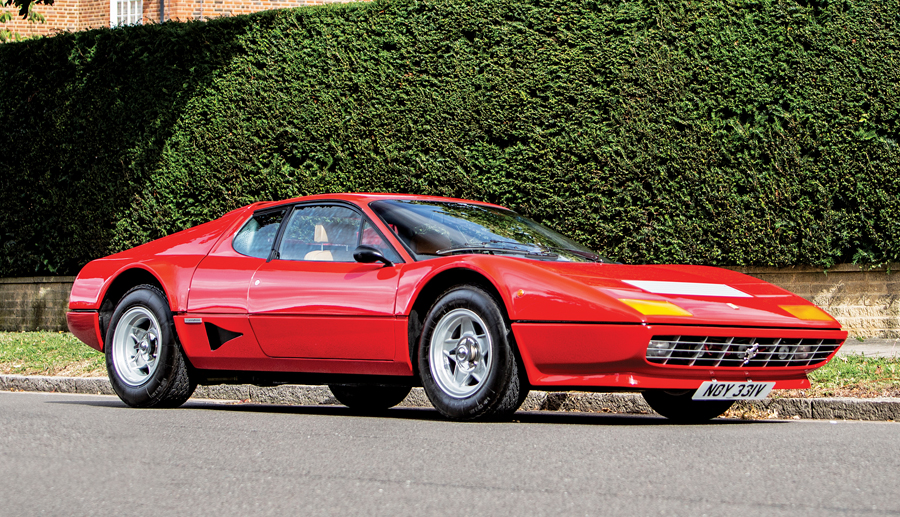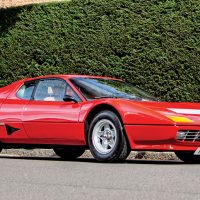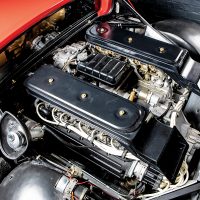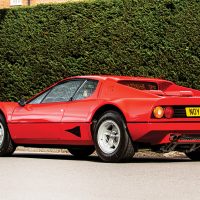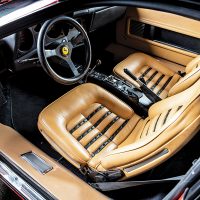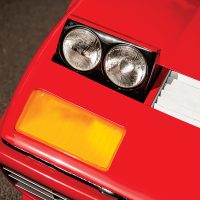- One of 929 produced
- Delivered new in Italy
- Circa 13,000 kilometers from new
- Ferrari Classiche certified
SCM Analysis
Detailing
| Vehicle: | 1980 Ferrari 512 BB Coupe |
| Years Produced: | 1976–81 |
| Number Produced: | 929 |
| Original List Price: | $62,500 |
| SCM Valuation: | $290,500 |
| Tune Up Cost: | $10,000 and up for an engine-out service with belts |
| Distributor Caps: | $500 |
| Chassis Number Location: | On frame tube in engine bay |
| Engine Number Location: | On top of block |
| Club Info: | Ferrari Club of America |
| Website: | http://www.ferrariclubofamerica.org |
| Alternatives: | 1963 ATS 2500 GT, 1980 Lamborghini Countach, 1975 Maserati Bora |
| Investment Grade: | B |
This car, Lot 254, sold for $279,388, including buyer’s premium, at Bonhams’ Zoute Sale, Knokke-Heist, BEL, on October 11, 2019.
Today a mid-engine car is almost commonplace. Many variations have been built and many are available.
We may look at one more salaciously than at a performance coupe, but we don’t view them as avant-garde or cutting edge. That was not always the case. The pioneer mid-engine offerings, such as Alejandro de Tomaso’s Vallelunga, Colin Chapman’s Lotus Europa, Ferruccio Lamborghini’s incredible Miura, and the ATS V8 were game changers. They put race-car handling in a street car and made show-car styling available to anyone with the right amount of cash in the bank.
The pioneers were also flawed.
Excepting the Miura, they were diminutive in size and short on power. Their handling was certainly superior to their contemporary front-engine cars, but they fell short as fully developed automobiles. The pioneers were shoestring engineered and lacked the finishing of a production car. Visibility, comfort and dependability were compromised in favor of performance and sizzle.
However, what they lacked in finish was more than made up for in excitement.
Ferrari a reluctant player
Enzo Ferrari had a reputation for dragging behind new technology, so it was no surprise that he was late to the mid-engine sports-car game. His vendors and distributors had pressured him to cash in on the mid-engine charge, but he was not quick to respond.
Ferrari understood his reply would need to be a serious car, rather than a toy. It would have to be well engineered and high quality.
In short, it had to be a Ferrari.
Enzo Ferrari examined, reimagined, and re-engineered the pioneers’ work into a superior product. Ferrari’s answer was the Dino, a blend of race-car styling and Formula 2 power. The Dino was an instant hit, and as a testimony to Ferrari’s insight, the Dino is a revered model that has survived through to today with no inherent issues.
The follow-up to the Dino would re-establish Ferrari’s position as the premier performance-car manufacturer. That car would require Ferrari to re-examine what a Ferrari GT was — and what it should be.
Ferrari’s mid-engine journey
Ferrari answered the Lamborghini Miura with the 365 GTB/4 “Daytona.” The Daytona was an exceptional Grand Touring car, but it was no competition to the Miura in the excitement department.
Lamborghini followed up the Miura with the Countach. The Countach addressed many of the shortcomings of the Miura and could be used for dependable transportation. There was no way Ferrari could ignore Lamborghini’s assault.
Ferrari’s new model was the 365 GT4 BB. GT indicated the car was a Grand Touring-class model, and 4 indicated it featured a 4-cam engine. The first B indicated the car was a berlinetta, or sports coupe. The second B was for Boxer, a European term for a flat engine.
Pininfarina was ready when Ferrari gave them the mid-engine commission. The 365 GT4 BB was introduced as a concept in 1971.
In 1974 it became the replacement for the Daytona and Ferrari’s 12-cylinder GT-class berlinetta. The 365 GT4 BB was the anti-Countach. The styling was elegant rather than risqué, and the engineering was flawless. Pininfarina’s design was exotic yet conservative, favoring their traditional curves over the geometric styling popular at the time.
The Daytona’s V12 engine was too tall for the new body, so Ferrari turned to a flat 12 to power the model. The engine picked was a 4.4-liter variation of the 3-liter flat 12 that had won 22% of the races they entered in the Formula One series and dominated the 3-liter World Championship Sports Car series.
On to the 512 BB
The 365 GT4 BB evolved into the 512 BB, and later, the 512 BBi.
The 512 BB featured a carbureted 5-liter version of the Boxer engine and about 200 other updates to the car. The 512 BBi featured a fuel-injected version of the 5-liter engine and a few more mostly cosmetic updates.
The mid-engine 12-cylinder Ferrari GT series would be short-lived.
By 1997, Ferrari reverted to a front-engine configuration for their 12-cylinder GTs. The mid-engine models got 8-cylinder power.
Ferrari’s 12-cylinder project consisted of just two series of three Boxer models and three Testarossa models. In total 12,310 mid-engine production 12-cylinder cars would be produced, about 20% more examples than Ferrari’s current yearly production.
Our subject 512 BB
Bonhams’ car was a 512 BB, one of just 929 produced.
The model is quite popular with collectors, as it features four 3-barrel Weber carburetors rather than the later 512 BBi’s fuel injection. Besides their very impressive appearance, the carburetors deliver immediate acceleration and an intake growl that is one of the most wonderful sounds in the automotive world.
By all appearances, our subject car was a quality example.
It showed just 14,042 kilometers (8,725 miles), which Bonhams, strangely, noted but didn’t hype. The car had always been in Europe and had none of the safety or emission modifications found on cars offered in the United States. It was shown with a full complement of books, tools, jack bag and a Ferrari Classiche certification.
A slumping market
Ferrari Boxer prices have definitely softened over the past few years. That has brought some consternation to some Boxer owners.
Owners who bought in at the top of the market have reason to lament, but when I hear complaints from owners that they can only sell their cars for $100,000 more than they paid for them rather than the $150,000 more they might have gotten a couple years back, I have no sympathy.
Our subject car sold near the top of Bonhams’ estimate, a phenomenon we see less often lately. The number was in line with some recent appraisal work that I’ve done on Boxers.
Mid-engine twelves hold a special place in Ferrari’s history. The buyer owns one of the best pieces of that history and should be happy with the purchase. ♦
(Introductory description courtesy of Bonhams.)
